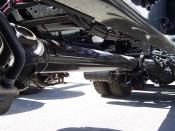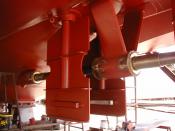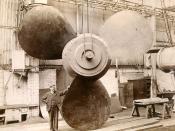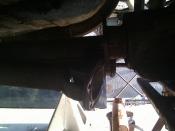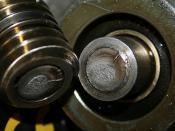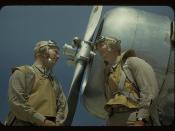Executive Summary:Introduction:Podded propulsion drives have become more and more popular within the maritime industry especially within the cruise industry. The first podded propulsion systems were implemented in early 1990s. Podded propulsion systems can generally provide high efficiency and maneuverability with lower noise generation than traditional shaft-driven rotor systems. They also provide a high degree of layout flexibility because of the relative independence of their location relative to the primary power plant of the vessel. However, since the implementation of the podded propulsion systems aboard cruise vessels, there have been significant malfunctions and failures of the bearings, which have resulted in lost revenue and lawsuits.
The purpose of this report is to research the effects of podded propulsion bearing failures within the maritime industry, mostly focused on the cruised industry. First, it is important to understand the technical side of the situation such as how the pods work and the causes of the bearing failures.
Background Information:In the traditional propulsion system, a medium to high speed diesel engine inside the shipÃÂs hull turns the shaft of the propeller through a gearbox, depending on the diesel engine. A low speed diesel engine is directly connected to the shaft causing the shaft to turn at engine speed. In a diesel-electric system, the diesel engine drives a generator, which then produces electricity that is fed to the main electrical bus. The main electric bus then feeds power to a propulsion motor or motors that turn the shaft. Also, all machinery runs off of the main electrical bus in a diesel-electric ship. Using electric cables rather than a mechanical transmission system also reduces vibration on board.
In order to maneuver on a traditional propulsion system, the vessel utilizes steering gear with a rudder. The command is given from the bridge and is converted from an electrical signal to a mechanical movement that causes hydraulic pumps to move the rudder. When entering a port, some vessels employ a stern and/or bow thruster, which aids in maneuvering. Also, a tug may assist in maneuvering depending on the port.
Podded Propulsion:The podded propulsion system employs the diesel electric concept as stated previously. However, the rest of the system is completely different. The propulsion unit is fixed outside the ship in a pod, which combines the functions of a propulsion motor, main propeller, rudder, and stern thruster. The pod itself can rotate 360 degrees and provide maximum maneuverability. The pod contains a fix pitched propeller, electric AC synchronous motor, exciter, propeller shaft, propeller shaft thrust support bearings, bilge pumps, and monitoring and control equipment. The steering unit, lubricating oil equipment, and ventilation and air cooling unit are all outside of the propulsion pod and inside the ship.
The reliability and effectiveness of podded propulsion has been proven over the last decade in the toughest ocean-going ship application; arctic tankers and ice breakers. In those non-passenger-carrying vessels, propulsion was provided by only one pod; cruise ships have two for additional maneuverability and redundancy. In the wake of the introduction of podded propulsion systems in cruise liners lies the wave of the future.
Several advantages of the podded propulsion unit include: an all electric ship, reduced exhaust gas emissions, flexibility in machinery arrangement, reduced number of main components, higher hydrodynamic efficiency, low noise and vibrations with reduced pressure pulses, excellent maneuvering characteristics, space savings in general arrangements, minimized crash stop distance, and easier shipyard logistic and construction. Also, the propeller blades on the pod face forward so as to pull versus push the ship through the water, which is more efficient. With conventional steering, aft-facing propellers need to ensure proper water flow over the rudder, but with podded propulsion, the propellers pull a vessel through the water rather than push it. The disadvantages that come with installing podded propulsion are higher capital costs and maintenance repairs as well as some power losses due to electric propulsion.
Bearing Failure:Pod drives implement thrust and support bearings to control axial and radial alignment of the propeller shaft respectively. The pod shaft bearing is a system that consists of the bearing itself, sealing, lube oil, monitoring equipment, operating methods, care and service.
Both the thrust and support bearings on the podded propulsion system have failed on numerous occasions. The primary cause of the bearing failures is a combination of many variables such as design, control, and maintenance. Early models of the pod drives were designed with bearings that were insufficient for carrying the types of loads present on the drives. This was due to the thermal expansion of the bearings while under load. The rise in temperature of the shaft, rotor, and structure has to be calculated and the bearings have to allow the differential thermal elongation of the shaft.
On cruise ships, the bearing failures seem to correspond to human error associated with controls and maintenance. Because of the large power and thrust output of the pod units, they should never face each other or face opposed from each other. When the blades face each other or opposed from each other, the directional thrust and water flow will cause a great amount of vibrations, which damage the bearings. The controls of the pod units must be closely observed from the bridge during maneuvering. Mates and Captains may forget the critical positions of the pod units during maneuvering and may cross into the ÃÂcritical zonesÃÂ causing damage to the pod units. To prevent the pod units from crossing each other, new control systems have been implemented on the bridge to keep one of the pod units perpendicular to the other unit during maneuvering. This system is controlled with a single joystick instead of two separate ones.
As far as maintenance is concerned, the lube oil system is of most importance to maintaining the life of the bearings and pod units. Every effort must be spent in order to achieve debris and water free lubricating oil. Today, automatic self cleaning filters can reach down to 10üm absolute mesh, guaranteeing optimum lubricating oil conditions. Water contamination from both shaft seals and cooling air humidity must be avoided either through coalescent filters or separators. The acceptable size limit of particles in the lube oil system is 50üm; anything larger than this is unacceptable. Another problem posed with maintenance is accessibility to the components in the pod unit. Due to the fact that, often, it is not possible to carry out repairs on the pod, many failures require the ship to be dry-docked. Then, the problem of finding an open dry-dock in the area arises. Despite remote monitoring equipment, failures can be sudden, unwarned, unexpected, and very expensive. Moreover, many propulsion pod repairs require the removal of the propeller shaft from the motor housing, which can be a time consuming procedure that must be performed by highly skilled personnel.
Due to the young age of the pod drives, the average lifetime of the bearings is still only theoretical. The longest experience that has been observed on a 14MW pod unit is eight years of continuous operation. The longest experience on a 20MW pod unit is five years and the bearings still seem to be in flawless condition.
Effects on the Maritime Industry:Eight cruise lines Carnival, Celebrity, Crystal, Cunard, Holland America, Mediterranean Shipping, Norwegian, and Royal Caribbean have a total of 12 azipod-propelled ships in service as of 2001; 17 others are being planned or under construction. 100 Azipod Units are in operation worldwide. That number seems much less than conventional propulsion system because of some disadvantages that will be discussed later on in this project.
The biggest installation was for Cunard Line's Queen Mary 2, which was scheduled to debut in late 2003. She is the largest ocean liner ever built and the first with a four-pod installation--two fixed pods and two azipods. The Queen Mary 2 have a maximum speed of 30 knots, which is helpful in establishing a regular trans-Atlantic schedule of crossings, even in midwinter's stormy weather. Queen Mary 2 will keep her status as the biggest passenger vessel until Aker Yards of Germany launches the new Genesis Project in 2008. Delivery from Aker Yards in Germany is scheduled for 2008 and 2009. Royal CaribbeanÃÂs Genesis project will be equipped with three Azipod units. She will be the biggest cruise liner in the world with 220,000 in gross tonnage, 360 m in length and accommodation for 5,400 passengers when she enters service in autumn 2009.
AdvantagesThe main advantages of ABB electric propulsion are:Reduced lifecycle cost by improving the operational economy with reduced fuel consumption and maintenance costIncreased payload through efficient modularization and flexible location of machinery componentsSafety and reliability with improved maneuverability, high redundancy and standardized proven technologyEnvironmental benefits from lower fuel consumption and emissions resulting from constant speed engine operation with optimized loading and high efficiencyBetter comfort for crew and passengers due to reduced vibration and noiseHigh performance due to maximum torque at zero speedFlexible and easy installation compared to diesel mechanical systemsThe pod can be rotated through 360 degrees to provide the required thrust in any direction. This eliminates the requirement for stern tunnel thrusters and ensures that these latest generation vessels can maneuver into the smallest of ports without the need for tug assistance. A further benefit is the ability to reduce propeller pressure pulses and propeller induced noise using the tractor pod concept. Pressure pulses can be the main source of propeller-induced vibrations by using the Mermaid thruster, passenger comfort is considerably enhanced. Azipod produces much lower noise and vibration levels so passengers can enjoy higher standards of comfort.
A typical power and propulsion-system arrangement in a cargo ship includes diesel generators for generating the electrical power needed on board and a separate diesel engine driving the main propeller shaft. This is a diesel-mechanical propulsion system and because the engine and propeller speed are rigidly coupled, fuel efficiency drops considerably at low speed. Azipod Ships are also considered as green ships because Azipod System burns less oil than conventional type.
Using electric cables rather than a mechanical transmission system also reduces vibration on board. The Azipod system arrangement in a cruise vessel has been shown to reduce fuel consumption by about 10 percent when compared to diesel-electric propulsion systems with a conventional shaft-line arrangement.
The propulsion plant also offers great flexibility in terms of power distribution. Ships that carry reefer cargo can use the electricity that is generated by the electric powered units. That eliminates the dependability on generators which is powered by fuel oil.
DisadvantagesInsurance Disputes that arises in insurance policies. Hull underwriters have not established a specific provision or warranty. In the event of a collision or allision, Azipod may be subjected to be the party at fault because of a failure in the azipod unit. The repair costs should be covered under normal warranty provisions.
ShipsÃÂs maintenance may be a difficulty in some cases. There are not many shipyards that can maintain or repair the damages of azipod. Ships need to be maintained in certain regions which mean more time and loss of profit.
Technical Difficulties may result in delays. Since the azipod units are mostly used by passenger vessels, delays may bring customer dissatisfaction.
Effects on Actual Maritime CompaniesShin Nihonkai Ferry operates an extensive network of ferry routes between the islands of northern Japan. The main reason for choosing Azipod propulsion was the increasing cost of bunker fuel. At 573 nautical miles, the Maizuru-Otaru route is the longest in the network. Because of its length, the route had always required three ferries to provide a daily service. These three ferries, operating at 20 knots, covered the distance in 30 hours and were able to keep consistent arrival and departure times in both ports. In order to provide a daily service with only two ferries, Shin Nihonkai needed to have larger vessels and those vessels should be able to maintain a cruising speed of 30.5 knots. The two ferries that were built for ShinNihonkai were equipped with the Azipod propulsion system in 2004. The company reported fuel savings of 20 percent, as well as 15 percent more transportation capacity, compared with ships of a similar size using diesel engines. Shin Nihonkai Ferry still operates daily service; however the unique solution enabled the company to have a better service with two ships. They have experienced no problems with the Azipod propulsion system.
Celebrity Cruise Lines has not been as lucky as Shin Nihonkai Ferry. They have had major problems with the Azipod propulsion system on their cruise liners. They have been forced time after time to send their ships to dry dock for emergency repairs to the Azipod system. During one horrendous stretch between March and April 2002 Celebrity was forced to dry dock four cruise liners for emergency pod drive bearing replacement. Each cancelled cruise costs Celebrity between $6 million and $10 million dollars in repairs, refunds, lost revenue and enticement discounts it must give on future cruises. Celebrity has filed a $300 million lawsuit against Rolls-Royce and Alstom Power Conversion, the companies that manufacture the Azipods they use. Celebrity claims that the pods ÃÂturned out to be a defectively designed and built product which was in fact at an experimental stage of its development and that it was fraudulently marketed.ÃÂRecommendations and Conclusion:Azipod propulsions are a very interesting and promising system. The first company that successfully designs and produces an extremely reliable pod will have great success in the shipping market, not only in regard to cruise vessels but with all vessels. In order to do so the causes of failures should be thoughtfully considered and redesigned. The technology to design a fully functional and reliable pod is available. Designers and operators must work together to increase the benefits of podded propulsion systems. The crews of the vessels have to be more responsible and monitor the equipment more closely. The mates and captains must be more aware during maneuverability. Designers need to have consideration for increased loads and better access to machinery and parts. Participating in these actions will help increase the success rate of these Azipod propulsions. The benefits of Azipod propulsions outweigh the disadvantages.
Appendix:http://www.sam-electronics.de/dateien/pad/broschueren/1.083.pdfhttp://www02.abb.com/global/seitp/seitp161.nsf/0/ca6780d2db778f3fc1257132003b8b42/$file/FrontRunner_0306.pdfhttp://www.ebearing.com/news2006/050901.htmhttp://www.marinelog.com/DOCS/PRINT/mmipods.htmlhttp://www.abb.com/cawp/db0003db002698/b4c6f2757969bba6c12571f100410217.aspxhttp://www.ebearing.com/news2002/032701.htmhttp://64.233.169.104/search?q=cache:FRNHCtVBCcEJ:www.freepatentsonline.com/7238066.html+invention+of+pod+propulsion&hl=en&ct=clnk&cd=1&gl=us
